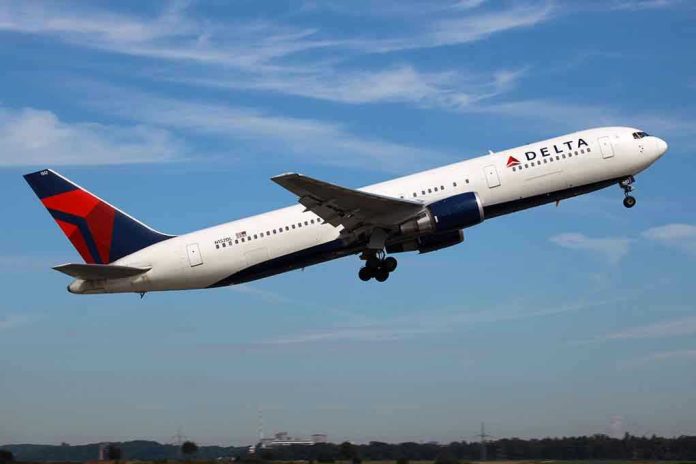
Delta Air Lines chose safety and operational continuity over speed, diverting a Detroit-to-Shanghai flight 2,000 miles to Los Angeles after a pilot fell ill—raising vital questions about airline emergency protocols and the real costs to passengers.
Story Snapshot
- Delta Flight 389 diverted 2,000 miles to LAX after a pilot’s sudden illness, delaying passengers by several hours.
- The decision prioritized a major hub for crew replacement over the nearest airport, highlighting airline contingency planning.
- Passengers faced significant disruption, but the flight ultimately landed safely and completed its journey to Shanghai.
- Experts say such incidents reinforce the need for robust crew health monitoring and highlight the operational complexity of long-haul flights over remote regions.
Pilot Illness Forces Delta to Choose Safety and Hub Access Over Nearest Airport
On a routine Detroit-to-Shanghai journey in August 2025, Delta Air Lines Flight 389 faced a critical mid-air emergency when a pilot became suddenly ill five hours into the flight, near Juneau, Alaska. Instead of diverting to the closest available airstrip, Delta’s crew opted for a 2,000-mile course correction south to Los Angeles International Airport (LAX). This decision, adding roughly eight hours to the trip, underscores the airline’s focus on ensuring both immediate medical attention for the crew member and the logistical benefits of landing at a major operational hub, where replacement staff and maintenance resources were readily available.
Delta flight takes 2,000-mile detour after pilot fell ill — adding 8 hours to journey https://t.co/X7UCXLEW70 pic.twitter.com/buaOhrLrA0
— New York Post (@nypost) September 1, 2025
Upon arrival in Los Angeles, passengers remained grounded for about three and a half hours as Delta organized a replacement crew and provided necessary ground support. Although the extended delay caused considerable frustration, the airline’s protocols ensured the safety of those onboard and compliance with federal aviation standards. Once the new crew boarded, Flight 389 resumed its journey, eventually landing in Shanghai late in the evening. Delta later issued a public apology, emphasizing that safety and operational continuity guided their decision-making throughout the ordeal.
Operational Protocols Highlight Hub-Based Diversion Strategy
The decision to divert to LAX, a significant Delta hub, rather than the nearest landfall, reflects established contingency planning for transpacific flights that often traverse remote airspace with few diversion options. Aviation safety experts explain that such protocols prioritize locations where airlines can quickly deploy fresh crew and access maintenance facilities, reducing the risk of extended disruptions. In this case, Delta’s operational center and the on-board captain exercised coordinated authority, working with air traffic control to secure a safe reroute and landing at LAX. The incident demonstrates how airlines must weigh passenger inconvenience against broader logistical and safety considerations in real time.
Historical precedent shows that long-haul flights over the Arctic and Pacific frequently require robust contingency plans due to limited infrastructure and unpredictable weather. Just months before, Delta Flight DL275 also diverted to LAX in response to technical issues, reinforcing the importance of hub airports in crisis response. The aviation industry, already attentive to crew health and redundancy, may see this event as further motivation for ongoing reviews of health protocols and diversion strategies, especially as ultra-long-haul flights become more common.
Impacts: Passenger Delays, Airline Costs, and Industry Lessons
For passengers aboard Flight 389, the diversion led to missed connections, extended travel times, and logistical headaches—common short-term consequences of such incidents. For Delta, the additional fuel, crew expenses, and compensation add direct operational costs that can reach millions in similar scenarios. Industry analysts point out that while the disruption is frustrating, prioritizing safety and having access to resources at a major hub ultimately reduces risk and ensures regulatory compliance. The event also serves as a reminder of the operational complexity facing U.S. airlines, especially when traversing sparsely populated northern routes.
Aviation experts emphasize that the trade-off between the fastest possible landing and the most resource-equipped diversion point is a calculated one. In this case, Delta’s decision to reroute to LAX allowed for a quick crew change and access to comprehensive services, minimizing the chance of further complications. As airlines continue adapting to the demands of global travel and increasing scrutiny on safety protocols, incidents like this highlight the need for robust planning, rapid decision-making, and transparent communication with the flying public.
Sources:
Delta flight diverts 2,000 miles to LA after pilot falls ill
U.S. flight diversions 2025 timeline
Delta flight takes 8-hour detour after pilot falls ill









